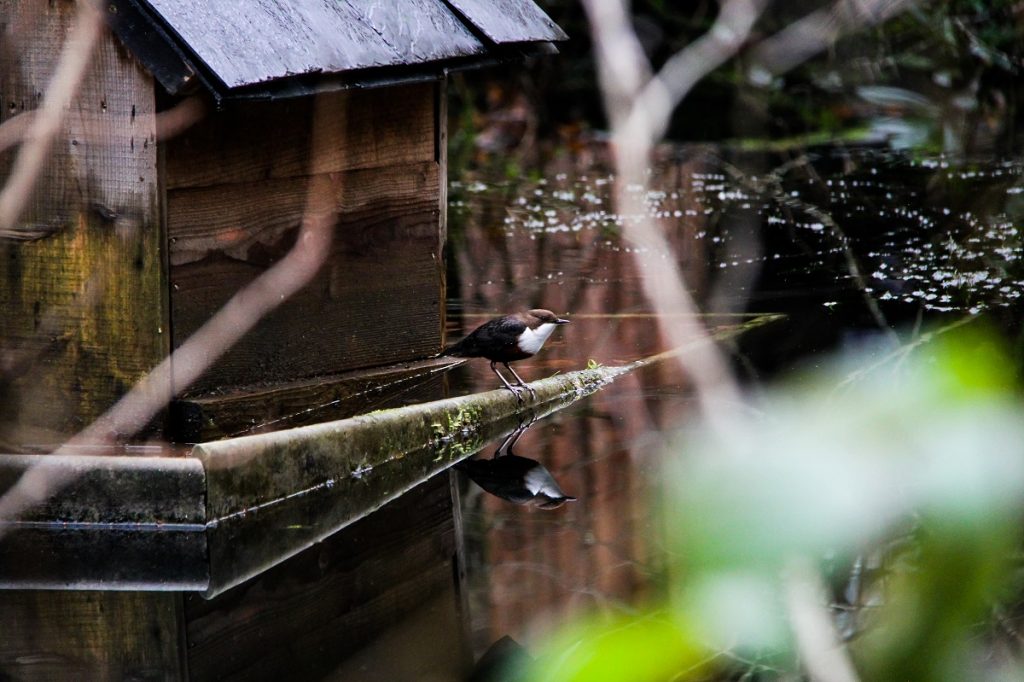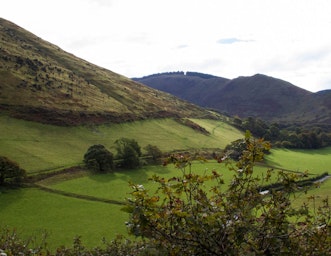
Bobbing along – the songbird that swims
March 10, 2021Home » Bobbing along – the songbird that swims
The UK’s only species of aquatic songbird is a regular visitor to the CAT ponds and waterways. Dulcie Fairweather takes us dipper spotting.
Often seen sitting on an exposed boulder by the water’s edge or perched in the lichen-draped branches around our main pond, we have recently welcomed the company of an endearing little dipper. With its dense chocolate brown plumage and white front, this intriguing bird brings a smile as it bobs up and down as we go about our daily tasks around site.
Once you see a dipper, you immediately understand why they’re called ‘dippers’. They are constantly bobbing and dipping their bodies, almost as if they’re in sync with a funky beat that we cannot hear. It has actually been observed that when a bird is disturbed, feeding or courting another dipper they can bob around 50 times in a minute – very impressive!
Our CAT dipper tends to be attracted to our ponds when the River Dulas, where it normally resides, is in flood, with sediment rendering visibility much poorer than usual. Whilst dippers are well-adapted to life on rivers with strong, challenging currents and white water, it seems that our habitat is a preferred area for this dipper to spend some of these wetter days.
Walking on water
What makes the dipper quite unique is its specialist method of walking along a riverbed in search of food. Dippers feed on insects and larvae, small crustaceans and molluscs but will sometimes also eat worms, tadpoles and small fish.
The species boasts numerous adaptations that give them this exceptional ability to feed underwater. Their bodies are streamlined so that the water flows easily past and they use their wings against the current to push themselves down. They are able to stay submerged in strong currents by holding onto stones with their feet – although they are unwebbed. Other adaptations include flaps over their nostrils to prevent water entering, eyes that can function underwater and blood that stores large amounts of oxygen.
In the spring, dippers lay a clutch of 4-5 white eggs in a dome shaped nest intricately crafted from mosses, grass stems and leaves. Built by both sexes, this structure usually faces down towards the river and has a wide entrance. Dippers often build their nests very close to water and in confined spaces such as cavities in banks, holes in walls or beneath a bridge. Nest sites are used by successive generations of birds. Amazingly, one such site was reportedly used for over 120 years.
A dip in population
Their current UK conservation status is Amber. The species has declined in west Wales, south-west and north-east England and various parts of Scotland since 1970, while the population has remained stable elsewhere.
Dippers are particularly sensitive to environmental factors like the acidification of streams (caused mainly by airborne pollutants creating acid rain). Forestry practices may have exacerbated this in some areas. Coniferous trees adjacent to streams and in catchment areas can trap acidic pollutants on their foliage, and subsequently have more acidic water draining from them. Acidification has a detrimental effect on dippers as it reduces the abundance of their aquatic invertebrate prey. It may also impact reproduction by causing calcium deficiency in egg-laying females resulting in thinning of eggshells.
Recent research indicates that urban dippers, birds who use our town and cities as habitat, lay eggs with significantly increased levels of pollutants – particularly the toxins used as flame-retardant chemicals in textiles, building materials, plastics and vehicles. Alarmingly, these concentrations in the eggs of Wales’ urban dippers are among the highest ever detected in songbirds anywhere in the world.

The dipper is considered as a key indicator species, as an abundance of birds in a river system suggests high numbers of invertebrates due to good water quality. The presence of our dipper at CAT is a good sign, confirming that our ponds are in a healthy, sustainable condition.
One for your Watchlist
Dippers are such an engaging species to spot – and keeping your eyes for the delightful dipper makes for a fun winter activity. These enigmatic birds can be seen any time of the year in the UK. Scan the river for exposed rocks, where white droppings can be a useful pointer for activity.
A little smaller than a thrush, they fly low and fast over the water and their sharp, single-note call – a high, repeated zit, is usually given in flight. You can also listen closely for their sweet, warbling song – dippers are the world’s only aquatic songbirds. Their song can be heard almost all year, as the birds use it to keep rivals out of their winter territories.
Find out more about our feathered friends
Meet more of the birds of CAT, exploring bird behaviour, ecology and ID, on our new Secret Life of Birds nature experience day. With dates starting this May, you can book your place now or choose a voucher to give you more flexibility.
The experiences have been designed with covid safety in mind and full refunds are available should restrictions prevent your attending.
- Woodland
- Climate Change
- Water and Waste
- Nature and Wildlife
- Autumnwatch
- Winterwatch
Related Topics
Related news


CAT Conversations: Sandy Stevens, CAT graduate
17th April 2025
CAT stories – Nick Parsons and Mike Russell
29th January 2025
Why we teach – communicating transformational social change
13th November 2024Email sign up
Keep up to date with all the latest activities, events and online resources by signing up to our emails and following us on social media. And if you'd like to get involved and support our work, we'd love to welcome you as a CAT member.
